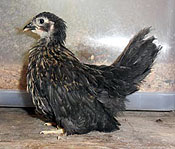

My breeding methods
Back in 1970, as a boy, I was taking photos at a country show in South Australia when I was approached by a kindly gentleman who happened to own the little Japanese bantam hen I was shooting. He said: "A Japanese bantam should look like a tiny shoebox with a big tail". When I started out with the breed myself, those words came back and I have strived to keep my birds fitting that description.

I always breed short legged to short legged birds. I discard the long legged ones early on as I see no point in breeding with them. Some breeders insist that the long legged birds are useful in the breeding pen, but I see no point in using birds that do not fit the standard and will give me chickens with long legs that I will only have to dispose of anyway. I have never had any issues with low fertility breeding this way.
In Australia, the standard awards 55 points for type and just 10 points for colour, so I ignore colour completely when mating up my breeding pens. As my birds are fixed in a crow-winged pattern, I always get birds with true Old English colours that are perfectly acceptable in the show pen.
The things I do look for are:
- Strong boxy type, deep and wide in body and bold of front
- Correct wing setting. The tips of the first secondary flights should always be the ones that fray and are damaged first. The wings should not droop downwards, rather they should sweep around the curve of the body so they almost sit parallel with the ground
- Short legs with stout round bone and sound toes. Many Japanese are weak in the outer toes, which often twist in the middle joint. I also like strong spurs like a game fowl as I believe this is a trait that helps keep the legs strong
- Short U-shaped backs in both sexes
- Soft, broad feather
- Strong combs, particularly in the males Japanese bantams often carry small double serrations and weak, pencilly serrations
- Strong eye colour.

I usually mate proven old cocks with hens early in the season. This sets the year with birds from proven and reliable breeders from the previous year. The hens are then mated in line with their sons from the previous season. I seldom mate pullets until they are almost first year hens. That's just me.
The myths about Japanese bantams
There are a number of myths surrounding Japanese bantams.
Myth 1: The lethal Cp gene. It is this gene that produces the short legs required in the show pen. Contrary to some belief, the chicks with the double-dose of this gene (the lethals) simply die in the shell quite early on in the incubation, fail to hatch and do not suffer. My own line of bantams gives an average fertility and hatch rate of around 70 per cent which is more than acceptable.
Myth 2: Japanese bantams are hard to rear. I have found Japanese bantam chicks to be vigorous, fast-growing and very active.
Myth 3: Japanese bantams are poor layers. I have found Japanese bantam hens lay incredibly consistently... they start early in the season and lay well into winter. They are also excellent mothers.
Finally...
These days, I cannot imagine not keeping this delightful little breed and can't see a time when my yard will be absent from them. Never have I kept a breed that has given me so much delight as these quaint little heart-breakers.
I thoroughly recommend Japanese bantams to anyone who loves the unusual, wants a challenge in breeding and showing, or simply wants some birds that are friendly, productive and take up little space.

